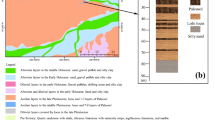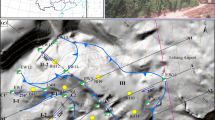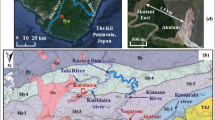Abstract
Because the construction of dams and hydro-electric power stations of Liujiaxia and Yanguoxia across the Yellow River in West Gansu Province, North-West China, inhabitants in the reservoir areas were resettled in Heifangtai Loess Platform. Irrigation thus started in 1968. Perched water table was significantly raised and resulted in many loess flow failures in the past 30 years. This type of landslide was often featured by long runout distance, high speed and recurrence. Laboratory tests along ICU and CSD stress paths were performed. It is shown that the loess has a strong strain-softening behavior and instability can occur in drained condition before undrained liquefaction. The failure mechanism of loess flow can be interpreted as the following process: with increasing perched water table, collapse in loess was first triggered in drained condition and led to undrained loading to adjacent soil in the lower saturated part of the loess platform. Under gravity loading applied by upper dry loess, undrained flow failure mobilized, eventually.






Similar content being viewed by others
References
Anderson SA, Sitar N (1995) Analysis of rainfall-induced debris flows. ASCE J Geotech Eng 121(7):544–552
Brand EW (1981) Some thoughts on rain-induced slope failures. In: Proceedings of the 10th international conference on soil mechanics and foundation engineering. vol 3, Balkema, Rotterdam, The Netherlands, pp 377–384
Brenner RP, Tam HK, Brand EW (1985) Field stress path simulation of rain-induced slope failure. Simulation of rain-induced slope failure. In: Proceedings of the 11th conference on soil mechanics and foundation engineering. vol 2, A.A. Balkema, Brookfield, pp 991–996
Castro G (1975) Liquefaction and cyclic mobility of saturated sands. ASCE Geotech Eng Div 101(6):551–569
Chu J, Leroueil S, Leong WK (2003) Unstable behavior of sand and its implication for slope instability. Canadian Geotechnical Journal 40:873–885
Clayton CRI, Matthews MC, Simons NE (1995) Site investigation, 2nd edn. Blackwell, Oxford, p 584
Corominas J (1996) The angle of reach as a mobility index for small and large landslides. Canadian Geotechnical Journal 33:261–271
Dai FC, Lee CF, Wang SJ, Feng YY (1999) Stress–strain behavior of a loosely compacted volcanic-derived soil and its significance to rainfall-induced fill slope failures. Engineering Geology 53(3–4):359–370
Derbyshire E (2001) Geological hazards in loess terrain, with particular reference to the loess regions of China. Earth Sci Rev 54(1–3):231–260
Derbyshire E, Dijkstra TA, Smalley IJ, Li YJ (1994) Failure mechanisms in loess and the effects of moisture content changes on remolded strength. Quat Int 24:5–15
Derbyshire E, Meng XM, Dijkstra TA (eds) (2000) Landslides in the thick loess terrain of North-West China. Wiley, Chichester, pp 1–288
Dijkstra TA, Rogers CDF, Smalley IJ, Derbyshire E, Li YJ, Meng XM (1994) The loess of north-central China: geotechnical properties and their relation to slope stability. Engineering Geology 36(3–4):153–171
Eckersley JD (1990) Instrumented laboratory flow slides. Geotechnique 40:489–502
Gabeta EG, Mudd SM (2006) The mobilization of debris flows from shallow landslides. Geomorphology 74:207–218
Gao GR (1988) Formation and development of the structure of collapsing loess in China. Engineering Geology 25:235–245
International Union of Geological Sciences IUGS (1995) A suggested method for describing the rate of movement of a landslide. Bull Int Assoc Eng Geol 52:75–78
Junaideen SM, Tham LG, Law KT, Dai FC, Lee CF (2010) Behaviour of recompacted residual soils in a constant shear stress path. Canadian Geotechnical Journal 47:648–661
Lade PV (1992) Static instability and liquefaction of loose fine sandy slopes. ASCE J Geotech Eng 118(1):51–71
Lin ZG, Wang SJ (1988) Collapsibility and deformation characteristics of deep-seated loess in China. Engineering Geology 25:271–282
Liu TS (1985) Loess and environment. China Ocean Press, Bei**g, pp 1–237
Sasitharan S, Robertson PK, Sego DC, Morgenstern NR (1993) Collapse behavior of sand. Canadian Geotechnical Journal 30:569–577
Scheidegger A (1973) On the prediction of the reach and velocity of catastrophic landslides. Rock Mech 5:231–236
Xu L, Dai FC, Min H, Kowng AKL (2010) Loess landslide types and topographic features at south **gyang platform, China. Earth Sci J China Univ Geosci 35(1):155–160 (in Chinese with English abstract)
Yamamuro JA, Lade PV (1997) Static liquefaction of very loose sands. Canadian Geotechnical Journal 34:905–917
Zhang DX, Wang GH, Lou C, Chen J, Zhou Y (2009) A rapid loess flow slide triggered by irrigation in China. Landslides 6:55–60
Acknowledgments
The financial support of the Research Grants Council, HKSARG (Project No: HKU7140/08E) is acknowledged.
Author information
Authors and Affiliations
Corresponding author
Electronic supplementary material
Below is the link to the electronic supplementary material.
Rights and permissions
About this article
Cite this article
Xu, L., Dai, F.C., Gong, Q.M. et al. Irrigation-induced loess flow failure in Heifangtai Platform, North-West China. Environ Earth Sci 66, 1707–1713 (2012). https://doi.org/10.1007/s12665-011-0950-y
Received:
Accepted:
Published:
Issue Date:
DOI: https://doi.org/10.1007/s12665-011-0950-y




